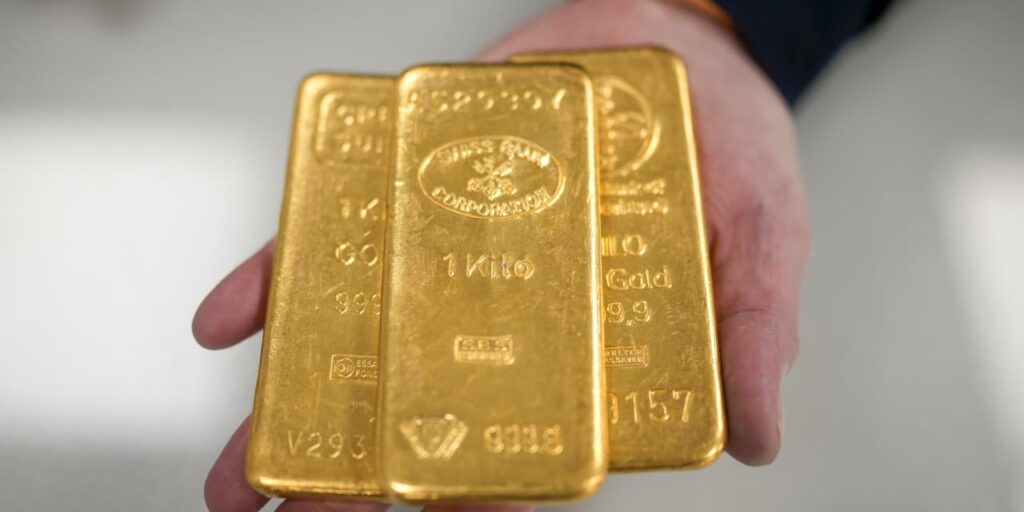Gold futures fell on Friday, with a stronger-than-expected U.S. nonfarm payrolls report helping the metal post a decline for the week, its first weekly loss in a month.
Prices saw volatile trading during the session as investors continued to weigh hints on the Federal Reserve’s plan for interest rates, with the release of monthly U.S. jobs data and a reading of business conditions at service-oriented companies leading to a wild ride Friday.
Gold for February delivery
GCG24,
+0.24%
GC00,
+0.24%
dropped in the few minutes following the release of monthly U.S. jobs data, showing a bigger-than-expected addition of 216,000 new jobs in December.
Data showing economic strength isn’t typically a catalyst for gold prices, said Adam Koos, president at Libertas Wealth Management Group.
Prices then saw a temporary spike higher after data from the Institute for Supply Management’s survey, a barometer of business conditions at service-oriented companies, revealed a fall to 50.6% in December from 52.7%.
Gold saw a “knee-jerk, short-term” reaction in prices but longer term, the precious metal is going to be “more sensitive to interest rates, the Fed, the dollar, and of course, the irrefutable law of supply and demand,” said Koos.
On Friday, December gold settled at $2,049.80 an ounce on Comex, down 20 cents, or less than 0.1%, for the session. Prices based on the most-active contract lost nearly 1.1% for the week after posting three consecutive weekly gains, according to Dow Jones Market Data.
Fed policy in focus
“Friday’s big swings in gold show how, for now at least, Fed policy trumps geopolitics in the futures market,” Adrian Ash, director of research at BullionVault, told MarketWatch.
““Friday’s big swings in gold show how, for now at least, Fed policy trumps geopolitics in the futures market.””
Alongside the ongoing attacks by Iran-backed Houthis on Red Sea shipping, this week’s actions by the U.S., Israel and Islamic State in Iraq, Lebanon and Iran, respectively, “make the risk of a region-wide conflict much greater,” he said.
But having slipped earlier this week on the retreat in Fed “rate cut euphoria, gold then got whacked by Friday’s jobs data, only to rebound on the weak ISM report — moving $40 in barely 90 minutes as futures traders rushed to reprice the odds of a March, if not January, cut,” he said.
Gold prices had ended 2023 strongly, with a gain of 11% for the fourth quarter, and with prices trading closer to the all-time highs they saw in early December. Most-active gold futures traded at a record, intraday high of $2,152.30 on Dec. 4.
The Fed has indicated that the rate forecast is still dependent on data, said Jerry Braakman, president and chief investment officer of Santa Ana, Calif.-based First American Trust.
While the Fed has broadcast that the federal funds rate is likely to drop later this year, Friday’s jobs report “supports the soft landing and higher-for-longer stance many were hoping for,” he said.
“That’s not positive for gold,” as the metal normally reacts best to lower rates, a weaker dollar, and slower economic growth, Braakman told MarketWatch. “The Fed can continue its fight against inflation, which is also a detractor to gold prices.”
Still, he said to be careful not to read too much into one month’s jobs report. “We still expect the U.S. economy to soften this year, leading to Fed rate cuts and strength for gold prices.”
On Wednesday, minutes from the Fed’s meeting mid-December showed that officials from the central bank said it was possible the economy could evolve in a manner that would make further rate hikes appropriate.
Some investors are beginning to “scoff at the idea of a rate cut by March,” said Libertas Wealth Management’s Koos.
“The Fed is “going to take their good time as they let out the slack on the leash they’ve tightened this past couple of years.””
He believes the Fed is “going to take their good time as they let out the slack on the leash they’ve tightened this past couple of years.”
Moves in the dollar
The U.S. dollar, meanwhile, was shot down once again in the fourth quarter of 2023, and on Friday, it fell toward 52-week lows, said Koos.
The ICE U.S. Dollar index
DXY
touched a low of 101.91 before inching higher in Friday dealings, poised for a weekly gain. The index’s 52-week intraday low was at 99.58 on July 14.
Read King dollar makes a comeback: Buck on track for best start to a year in nearly a decade
“If those lows are broken decisively, it would certainly add a nice tailwind to gold,” said Koos.
On the other hand, if the greenback “bounces off this floor of support and continues higher — above the October highs — the next stop would be all-time-highs, which printed way back in September of 2022,” he said. “In a currency environment that looks like this, the yellow metal would feel like it’s running uphill with the wind in its face.”
Gold’s record highs
That being said, inflation is still weakening around the world, and while we don’t know how much the Fed will cut rates or when, “we do know they’re going down before they go up again,” said Koos. “So when you put all the puzzle pieces together, it seems to me that we’ll likely see a huge, big-base breakout and corresponding all-time-highs in gold at some point in 2024,” he said.
First American Trust’s Braakman, meanwhile, said that a move in gold prices to a new high will depend on further U.S. economic deterioration.
“That’s not likely in the next few weeks, but it could happen later this quarter and is even more likely in the second quarter,” he said.
Read the full article here

